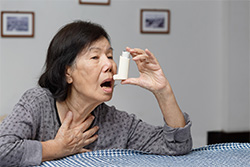Keep Winter Asthma Under Control

Here we are in the midst of winter — with the shorter, colder days and the health-related risks the season brings. But for asthma sufferers, another threat looms large at this time of year: increased asthma attacks.
Asthma is a chronic lung disease that inflames and narrows the airways, causing recurring periods of wheezing, chest tightness, shortness of breath, and coughing. The cold weather and an increase in pathogens (germs) causing respiratory infections are the main reasons asthma is more active in the winter months.
Asthma attacks vary by person, but in addition to cold weather and respiratory infections, typical triggers include animal dander, dust, pollen, and smoke, to name a few. The condition affects over 22 million people in the U.S., including 6.5 million children, but the good news is that asthma control is achievable for almost every patient.
Controlling winter asthma
- Practice good hygiene. Wash hands with soap and water thoroughly and frequently. This is one of the simplest and best ways to avoid spreading germs.Alcohol-based hand sanitizers and moist towelettes are also recommended.
- Get vaccinated each year. The Centers for Disease Control and Prevention recommends that people with asthma get the injectable form of the flu vaccine made with inactivated [killed] flu virus rather than the nasal spray vaccine which contains live virus. Your doctor may also recommend a pneumonia vaccine for extra protection.
- Breathe right when outdoors. That means breathing through your nose, not your mouth when you’re out in the cold because the nose warms up the air for the lungs. Another way to warm and humidify the cold air you breathe is to wear a scarf or muffler over your nose and mouth.
- Make your home a safe zone. Keep the house cool, dry, and clean. Replace filters before turning on your heating system so as not to release the debris that can trigger an asthma attack. If smoke triggers your asthma, avoid fireplaces.
- Exercise indoors. When it’s cold, exercise indoors whenever possible.
- Create an asthma action plan: This plan is essential in helping you manage your condition should a problem or attack occur. According to the American Lung Association, the plan should include a list of your asthma triggers, in addition to the specific symptoms you need to be mindful of — such as coughing, wheezing or shortness of breath. The plan should also list your regular medications, the signs they control, and what to do in the event of an asthma emergency. It is also wise to share your plan with family and friends, so they know what to do should you need assistance.
In the end, it’s a matter of being proactive. It’s important towork with your doctor to create a customized treatment plan, to be compliant with all medications, and to get regular checkups all year round to keep your condition in check. If your asthma symptoms tend to worsen in the cold weather, talk with your doctor about how to manage these symptoms. A change in medication may be needed during the winter season.
To find a physician, please visit nyp.org or call 877-697-9355.


